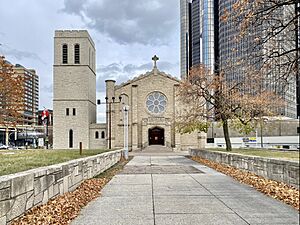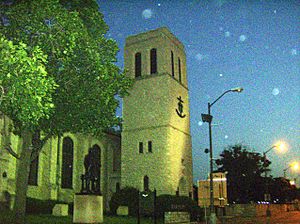Mariners' Church facts for kids
Quick facts for kids Mariners' Church of Detroit |
|
|---|---|
 |
|
| Location | Detroit, Michigan |
| Country | United States |
| Denomination | Anglican Church in North America Reformed Episcopal Church |
| History | |
| Founded | 1842 |
| Founder(s) | Julia Anderson |
| Administration | |
| Diocese | Mid-America |
The Mariners' Church of Detroit is a historic church located in Downtown Detroit, Michigan. It was started in 1842 to help sailors and people traveling on the Great Lakes. The church follows Anglican traditions in its worship services.
For many years, it was part of the Episcopal Diocese of Michigan. However, in 1992, a court decided that it was an independent church. The church is now connected with the Anglican Church in North America. In 1971, the church was added to the National Register of Historic Places, which lists important historical places.
Outside the church, there is a bronze statue of George Washington. This statue was placed there in 1966. It is a copy of an earlier artwork. The spot was chosen because it was once the location of Detroit's first Council House.
Contents
History of Mariners' Church
How the Church Began
The Mariners' Church was founded because of a generous gift from a woman named Julia Anderson. She owned a large house at Woodbridge and Woodward streets. She decided to donate the land where her house stood.
At that time, the Erie Canal had just been completed. This meant many more ships and sailors were coming through the area. Julia Anderson felt that these sailors needed spiritual support. So, the Mariners' Church was officially started in 1842. The church building we see today was finished and dedicated in 1849.
The first church building was made of wood. When the new stone church was ready, the old wooden one was sold. Another church, Historic Trinity Lutheran Church, bought it for $200. They moved the building to a different street.
A Stop on the Underground Railroad
Before the Civil War, the Mariners' Church played an important role. It was a stop on the Underground Railroad. This was a secret network that helped enslaved Black people escape to freedom in Canada.
In 1925, the church also started Mariners' Inn. This place helps people who are experiencing homelessness and need support. It offers counseling and other services.
Moving the Church Building
In 1955, the church building was almost torn down. This was to make space for a new city center. George Stark, who was a trustee of the church and a writer for The Detroit News, asked people for help. He encouraged his readers to donate small amounts of money, like $5 or $10. The goal was to raise enough money to move the huge limestone church building. It weighed about 60,000 pounds (27,216 kg).
The plan was to move it 880 feet (268 meters) to the east. This amazing effort was even featured in Life magazine in April 1955. George Stark's appeal worked! Enough money was raised to move the church. There was even money left over to add new stained glass windows, a new entrance, and a tower. The inside of the church was also redecorated.
During the move, workers found a secret tunnel under the building. This tunnel was from the church's days as a stop on the Underground Railroad. Today, the church sits partly over the Detroit–Windsor Tunnel.
The new location for the church on Jefferson Avenue was also a historic spot. It was where the Indian Council House was built after a big fire in 1805. This house was used for meetings with local Native American tribes. It was also where the first Protestant church services in Detroit were held. Later, it became the office for the Army Corps of Engineers Topographical Corps. This office was started by Colonel John Anderson, who was Julia Anderson's husband.
Church Independence
In 1990, the Episcopal Diocese of Michigan filed a lawsuit. They claimed that Mariners' Church was part of their diocese. However, Mariners' Church argued that it was an independent church. The courts agreed with Mariners' Church in 1990 and again in 1992. This meant the church could remain independent.
The church uses older versions of the Book of Common Prayer for its services. For many years, from the 1950s to the 1980s, their services were broadcast on the radio station WWJ (AM).
Church Building Design
The Mariners' Church building is made from Lannon stone, which comes from Wisconsin. It is built in the Gothic Revival style, which looks like old English churches. The building is about 49 feet (15 m) wide and 94 feet (29 m) long.
The east and west walls of the church have three sections. The south wall has seven sections. The east wall has a large window above the chancel, which is the area around the altar. This window is 15 feet (4.6 m) wide and 25 feet (7.6 m) high. There are smaller windows on each side of it. At each corner of the church, there is an eight-sided support structure called a buttress.
The west wall has a large, round rose window that is 12 feet (3.7 m) across. Above this window, there used to be a small bell tower. When the church was in its first location, the north and west sides were hidden by other buildings. After the 1955 move, a new bell tower was added. The north wall, which now faces Jefferson Avenue, was rebuilt to look like the south wall, and new windows were added there.
Inside the Church
The ground floor of the church now has offices and meeting rooms. But when the church was first built, this area was rented out to businesses to help the church earn money. The first tenants were the Post Office and a bank. Later, there was a grocery store, a barber shop, and a laundry. Before the church was moved, the main entrance was also on the ground floor.
The Sanctuary
The sanctuary is the main worship area. It is about 43 feet (13 m) wide and 75 feet (23 m) long. At the back, there is a gallery for the organ. The ceiling is made of wood with exposed beams. These beams were painted to look like oak wood. The walls are covered with a special fabric.
The church has a pipe organ. The first organ was installed in 1849. In 1966, a new organ was given to the church. Then, in 2007, a new organ with 78 sets of pipes was installed.
The beautiful stained glass windows were made in 1955 by J&R Lamb Studios in New York City. The large rose window on the west side was a gift from the Browning family. It was given in memory of their mother. This window looks like a ship's compass, which is perfect for a church dedicated to sailors. The Browning family was involved in shipping on the Great Lakes. The windows on the side walls show scenes from Detroit's history and stories from the Bible.
1971 Renovations
In 1971, the church had more renovations. The Chancel area was made larger. The Altar, the screen behind the altar (called a Reredos), the pews, and the floor were all restored. The lighting, sound, and electrical systems were updated. The sanctuary walls were covered with new material. The wooden parts of the rose window were replaced with stone. An air conditioning system was installed, and the outside woodwork was painted.
Remembering Those Lost at Sea
Since it was founded to serve mariners, the church has special services to remember them. Every March, they hold a "Blessing of the Fleet" for those who are going out to sea. In November, they have a "Great Lakes Memorial Service" to remember all the people who have lost their lives on the Great Lakes.
In November 1975, the church bell rang 29 times. This was to mourn the loss of the freighter Edmund Fitzgerald. Each ring was for one of the 29 crew members who were lost. The church continued to hold an annual memorial for the Edmund Fitzgerald until 2006. During these services, the names of the crew members were read, and the church bell was rung.
The Mariners' Church is even mentioned in Gordon Lightfoot's famous song, "The Wreck of the Edmund Fitzgerald." The song says: "In a musty old hall in Detroit, they prayed in the Maritime Sailors' Cathedral. The church bell chimed 'til it rang, 29 times, for each man on the Edmund Fitzgerald." In 1985, Gordon Lightfoot himself performed the song at the tenth memorial service for the Edmund Fitzgerald. After seeing the church, Lightfoot said he had written the song with a wrong idea about the church. He said he would now refer to it as a "...rustic old hall..." in future performances. On May 2, 2023, after Gordon Lightfoot passed away, the church bell rang 30 times. It rang once for each of the 29 crew members of the Edmund Fitzgerald and once in memory of Lightfoot.
On November 12, 2006, the church changed its memorial ceremony. Instead of just remembering the Edmund Fitzgerald, they decided to include all the more than 1,000 lives lost on the Great Lakes. In 2006, the bell at Mariners' Church rang eight times. Five rings were for the five Great Lakes. A sixth ring was for the St. Clair and Detroit rivers. A seventh ring was for the St. Lawrence Seaway. And an eighth ring was for military personnel who died.
Leaders of the Church (Rectors)
- Horace Hills 1849–?
- Rufus Murray 1856–?
- Alfred Lee Brewer 1859–?
- A. M. Lewis 1865–?
- E. W. Flower 1872–?
- William Charles 1877–?
- Paul Ziegler 1855–1915
- Hubert W. Wells 1915–1917
- Harry C. Robinson 1917–1921
- John H. Lever 1921–1925
- Harry I. Pearson 1925–1929
- George Backhurst 1929–1942
- David R. Covell 1942–1946
- G. Paul Musselman 1946–1953
- Elmer B. Usher 1956–1964
- Richard W. Ingalls, Sr. 1965–2006
- Richard W. Ingalls, Jr. 2006–2012
- William Fleming 2013–2018
- Jeff Hubbard 2018–2022
- Todd Meyer 2023–present
From 1925 to 1957, Mariners' Church did not have regular worship services. During this time, the Rector mainly served as the Superintendent of Mariners' Inn.
Images for kids
See also
 In Spanish: Iglesia de los Marineros (Detroit) para niños
In Spanish: Iglesia de los Marineros (Detroit) para niños





